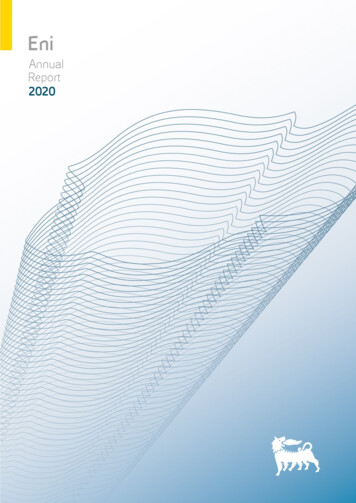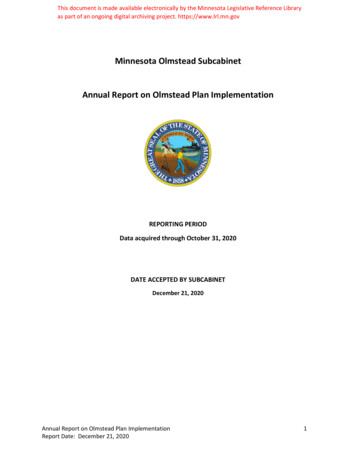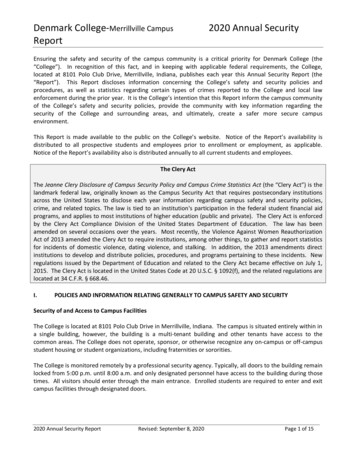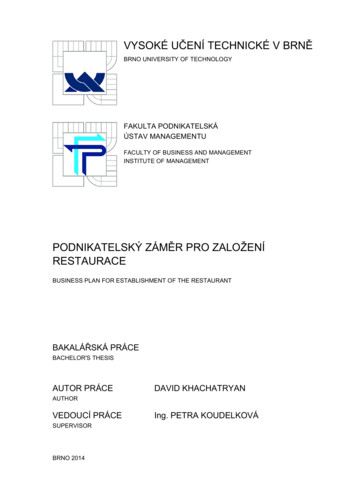
Transcription
EniAnnualReport20201MANAGEMENT REPORT1Activities2Business model4Responsible and sustainable approach6Letter to shareholders8Eni at a glance14Stakeholders engagement activities18Strategy20Integrated Risk Management26Governance32Operating reviewNatural Resources40Exploration & Production42Global Gas & LNG Portfolio66Environmental activities70Energy Evolution72Refining & Marketing and Chemicals74Eni gas e luce, Power & Renewables82Financial review and other informationFinancial review88Risk factors and uncertainties114Outlook135Consolidated disclosure of non-financial information (NFI)136Other information182Glossary1832CONSOLIDATED FINANCIAL STATEMENTS1863ANNEX332DisclaimerThis Annual Report contains certain forward-looking statements in particular under the section “Outlook” regarding capital expenditures,dividends, buy-back programs, allocation of future cash flow from operations, financial structure evolution, future operating performance,targets of production and sale growth and the progress and timing of projects.By their nature, forward-looking statements involve risks and uncertainties because they relate to events and depend on circumstancesthat will or may occur in the future. Actual results may differ from those expressed in such statements, depending on a variety of factors,including the impact of the pandemic disease; the timing of bringing new oil and gas fields on stream; management’s ability in carryingout industrial plans and in succeeding in commercial transactions; future levels of industry product supply; demand and oil and naturalgas pricing; operational problems; general macroeconomic conditions; political stability and economic growth in relevant areas of theworld; changes in laws and governmental regulations; development and use of new technology; changes in public expectations and otherchanges in business conditions; the actions of competitors. “Eni” means the parent company Eni SpA and its consolidated subsidiaries.
Eni Annual Report 2020Management report Consolidated financial statements Annex2ActivitiesEni activities: the value chainEni is a global energy company, engaged in the entire value chain: from the exploration, development and extraction of oil and natural gas, to the generation of electricity from cogenerationand renewable sources, traditional and biorefining and chemicals, and the development ofcircular economy processes. Eni extends its reach to end markets, selling gas, electricity andproducts to retail and business customers and local markets. Both CO2 capture and storageinitiatives and forest conservation projects (REDD initiatives) will be implemented to absorbresidual emissions.Consolidated expertise, technologies and geographical distribution of assets are Eni levers tostrengthen its presence along the value chain.Along this path, Eni is committed to become a leading company in the production and sale ofdecarbonized energy products, increasingly customer-oriented. Decarbonization will be achieved through the implementation and strengthening of existingtechnologies and activities such as biorefineries with an increasing input of raw materialfrom waste; Circular economy with increased use of biomethane, waste products and recycling of endproducts; Efficiency and digitalization in operations and customer services; Renewables through increased capacity and integration with the retail business; Blue and green hydrogen to power Eni biorefineries and other highly energy-intensive industrial activities; Natural or artificial carbon capture to absorb residual emissions through REDD forest conservation initiatives and CCS projects.Gas will be an important support to intermittent sources in the energy transition.operating inCountries6831,000beyondour 4EXPLORATION & PRODUCTIONGLOBAL GAS & LNG PORTFOLIOREFINING & MARKETING AND CHEMICALSENI GAS E LUCE, POWER & RENEWABLES15ASIA ANDOCEANIA2210
Eni Annual Report 2020Management report Consolidated financial statements Annex3EXPLORATION AND DEVELOPMENTOIL & GAS PRODUCTIONPRODUCTION FROMRENEWABLE RCHASEOF GAS FROMTHIRD PARTIESCAPTURE, STORAGEAND USE OF CO2AND REDD PROJECTSTRADING & SHIPPINGTRADITIONAL ANDBIOREFININGAND PETROCHEMICALSELECTRICITYGENERATIONPURCHASE OF BIOAND RENEWABLERAW MATERIALSREMEDIATION,WATER & WASTEINTO DEVELOPMENTLOCAL MARKETSPRODUCTSBUSINESSMARKETSELECTRICITYOIL & GASTRADITIONALAND BIOCHEMICALSLUBRICANTSFUELBIOFUELRETAILMARKETS
Eni Annual Report 2020Management report Consolidated financial statements Annex4Business ModelEni business model is aimedat the creation of value forall stakeholders through astrong presence along theentire value chain of energy.Eni aims to contribute,directly or indirectly, tothe achievement of theSustainable DevelopmentGoals (SDGs) of theUnited Nations 2030Agenda, supporting a justenergy transition, whichresponds with concrete andeconomically sustainablesolutions to the challengesof combating climatechange and giving access toenergy in an efficient andsustainable way, for all.Eni organically combines its business plan with the principles of environmental and socialsustainability, extending its range of action along three pillars:1. operational excellence;2. carbon neutrality by 2050;3. alliances for development.1. First of all, Eni business is constantly focused on operational excellence. This translatesinto an ongoing commitment to valuing people, safeguarding both the health and safetyof people and asset integrity, protecting the environment, integrity and respect for humanrights, resilience and diversification of activities and ensuring sound financial discipline.These elements allow the company to seize the opportunities related to the possible evolutions of the energy market and to continue on the path of transformation.2. Second, Eni’s business model envisages a decarbonization path towards carbon neutrality based on an approach oriented to emissions generated throughout the life cycle ofenergy products and on a set of actions that will lead to the total decarbonization of processes and products by 2050. This path, achieved through existing technologies, will allowEni to totally reduce its carbon footprint, both in terms of net emissions and in terms of netcarbon intensity.3. The third guideline refers to alliances for the promotion of development through theenhancement of the resources of the Countries where it operates, promoting access toelectricity and promoting Local Development Programmes (LDPs) with a broad portfolio ofinitiatives in favour of communities. This distinctive approach, referred to as Dual Flag, isbased on collaborations with other internationally recognized players in order to identify theneeds of communities in line with the National Development Plans and the United Nations2030 Agenda. Eni is also committed to creating job opportunities and transferring its knowhow and expertise to its local partners.Eni’s business model is developed along these three pillars by leveraging internal expertise,the development and application of innovative technologies and the digitalization process.A fundamental element of the business model is the Corporate Governance system, inspiredby the principles of transparency and integrity, outlined further in the Governance section.
Eni Annual Report 2020Management report Consolidated financial statements Annex5VALUE CREATION FOR STAKEHOLDERSThrough an integrated presence all along the energy value chainOPERATIONALEXCELLENCECARBON NEUTRALITYBY 2050ALLIANCESFOR DEVELOPMENTHealth, Safety and EnvironmentLife cycle GHG emissionsapproach(Scope 1, 2 and 3)Dual Flag approachHuman Rights & IntegrityPublic-private partnershipsResilience and DiversificationCapital disciplineTRANSFORMATIONAND PORTFOLIOFLEXIBILITYSet of concrete actions for the entiredecarbonization of processesand productsINTERMEDIATE OBJECTIVESOF NET REDUCTIONIN ABSOLUTE TERMS ANDOF EMISSION INTENSITYJob creationand know-how transferLOCAL DEVELOPMENT PROGRAMSIN ACCORDANCE WITH2030 AGENDACOMPETENCESTECHNOLOGICAL INNOVATION AND DIGITALIZATION
Eni Annual Report 2020Management report Consolidated financial statements Annex6Responsible and sustainable approachCOMMITMENTSEni adopts a responsibleand sustainable approachin order to ensure valuecreation in the mediumand long term for thecompany and for allstakeholders. This approach,the importance of which iseven more evident after theoutbreak of the pandemic,is confirmed in thecompany’s Mission, whichclearly expresses thecommitment of Eni toplay a decisive role in thejust transition process fora low carbon future thatguarantees efficient andsustainable access to energyfor all in order to contributeto the achievement of theSustainable DevelopmentGoals (SDGs).CARBONNEUTRALITYBY 2050COMBATINGCLIMATE CHANGEEni has defined a medium-long term planto take full advantage of the opportunitiesoffered by the energy transition andprogressively reduce the carbon footprintof its activities, committing to achieve totaldecarbonization of all its products andprocesses by 2050OPERATIONALEXCELLENCEPEOPLEEni is committed to supporting the justtransition process by consolidatingand developing skills, enhancing everypsychophysical dimension of its people andrecognising diversity as a resourceHEALTHEni considers the protection of the healthof its people, families and communitiesin the Countries where it operates to be afundamental requirement and promotes theirphysical, psychological and social well-beingSAFETYEni considers workplace safety an essentialvalue to be shared among local employees,contractors and stakeholders and it iscommitted to reduce incidents down to zeroand to preserve assets integrityRESPECTFOR THEENVIRONMENTEni promotes the efficient managementof natural resources and the safeguard ofprotected areas relevant to biodiversity,through actions aimed at improving energyefficiency and the transition to a circulareconomy and identifying potential impactsand mitigation actions and is committed notto carry out hydrocarbon exploration anddevelopment activities in UNESCO WorldHeritage SitesHUMAN RIGHTSEni is committed to respecting Human Rightsin its activities and to promoting their respectwith partners and stakeholdersTRANSPARENCYAND INTEGRITYIN BUSINESSMANAGEMENTEni carries out its business activities withfairness, correctness, transparency, honesty,integrity and in compliance with the lawsCOOPERATIONMODELThe cooperation model integrated into thebusiness model is a distinctive feature of Eni,which aims to support Countries in achievingtheir development goalsTECHNOLOGICALINNOVATIONFor Eni, research, development and rapidimplementation of new technologies are animportant strategic lever to drive businesstransformationALLIANCESFORDEVELOPMENT
Eni Annual Report 2020Management report Consolidated financial statements Annex7MAIN RESULTS 2020 SUSTAINABLE DEVELOPMENT GOALS-26% GHG emission intensity index upstream vs. 2014-39% volume of hydrocarbons sent for routine flaring vs. 2014-90% upstream methane fugitive emissions vs. 2014 (TARGETREACHED)31,495 employees in service at 31 December (reported -1.7% vs. 2019) 2.3 percentage point increase in women hired (34.6% in 2020vs. 32.3% in 2019)Approx. 1.04 million hours of training (-23.6% vs. 2019)13,300 professional profiles mapped to date354,192 of health services provided222,708 registrations to health promotion initiativesTRIR(a) 0.36Promotion of in-depth initiatives on the Human Factor to counteraccident risksRelaunched and enhanced the “Safety starts @ home” campaign inview of the new ways of workingAdherence to the 4 principles for solutions based on “Together withNature”Extension of biodiversity risk mapping to the R&M pipeline network91% reuse of fresh water-11% fresh water withdrawn vs. 2019-19% waste generated by production activities vs. 2019-7% barrels spilled from operational oil spills vs. 2019Ranked by the CHRB(b) as first among 199 companies evaluatedAdherence to the Voluntary Principles on Security and Human RightsIssuance of the new Code of EthicsIssuance of the new Eni Supplier Code of ConductIssuance of a new Policy on Indigenous Peoples in Alaska97% security contracts with Human Rights clauses100% new suppliers assessed according to social criteriaMembership in EITI(c) since 20059 Countries where Eni supports the EITI Multi Stakeholder Groupsat local level31 internal audits conducted with anti-corruption checksPublication Country-by-Country Report(d)Publication of Eni position on contractual transparency 96.1 million invested in local developmentCooperation agreements signed with World Bank, USAIDand civil society organizations 157 million invested in research and development25 new applications for first patent filings, of which 7 concernrenewable sources(a) Total Recordable Injury Rate.(b) Corporate Human Rights Benchmark.(c) Extractive Industries Transparency Initiative.(d) Report for the assessment of tax risk by the Financial Authorities that collects data on turnover, profits and taxes aggregated with reference to the jurisdictions in which Eniconducts business.
Eni Annual Report 2020Management report Consolidated financial statements Annex8Letter to shareholdersLucia CalvosaChairmanClaudio DescalziChief Executive Officer andGeneral ManagerDear shareholders,2020 was a year like no other, which will forever be remembered for the dramatic events we haveexperienced and for the unprecedented challenges that our Company has faced. The COVID-19pandemic affected everybody’s lives, every activity and the energy industry with a magnitude thatexceeded all previous crises. The trading environment in 2020 saw the largest oil demand dropin history, down by an estimated 9%.In tackling COVID-19, we reacted fast, finding inside our Company the energy, resources andflexibility to overcome this crisis. First, we implemented effective measures to preserve thehealth of the 60,000 people who work within Eni and with Eni at all our offices and productionhubs, as well as to ensure the continuity of our operations also through the involvement of oursuppliers. Furthermore, in collaboration with local authorities, Eni has taken immediate actionto reorient local development projects to better respond to the urgent needs of the most vulnerable populations.During the most acute phase of the downturn, we have taken decisive measures to strengthenthe financial and capital resilience of the company, defining clear priorities in the cash allocation. Through the review of our short-medium term plans we have reduced the disbursementsfor costs and capital expenditure by 8 billion in the period 2020-2021, thus reshaping theproduction growth profile. We have defined an innovative dividend policy, based on a fixedcomponent, which will be reassessed going forward based on the achievement of Eni’s industrial objectives, and a variable component linked to the scenario, in order to adapt the dividendto market volatility, while the buy-back has been suspended.Thanks to these actions, we were able to generate an adjusted cash flow of 6.7 billion, able tofund 100% of our organic capital expenditure, which were revised to 5 billion, leaving a surplusof 1.7 billion despite the large impact of the crisis on our cash receipts which contracted byaround 6 billion compared to the forecasts at the beginning of the year.The Company, also leveraging the issuance of two hybrid bonds for a total amount of 3 billion,has successfully overcome the worst phase of the downturn, retaining the leverage within themanagement comfort zone at 0.3 as of December 31, 2020 and achieving to keeping our netdebt flat versus last year. These actions, sustained from our credit standing, were clearly appreciated by the financial markets.Despite the crisis, we have improved and accelerated our decarbonization strategy and today weannounce the even more ambitious goal of zeroing all our emissions (Scope 1, 2 and 3) linked tothe entire life cycle of all the products traded by our organization by 2050.In this context, in June 2020 we reshaped Eni’s organization by setting up two new BusinessGroups: Natural Resources, which will maximize the value of Eni’s Oil & Gas upstream portfoliofrom a sustainable perspective, with the objective of reducing its carbon footprint by scaling upenergy efficiency and the development of projects for the capture and storage of carbon dioxide, and the Energy Evolution, which will focus on growing the businesses of power generation,transformation and marketing of products from fossil to bio, blue and green. The two BusinessGroups will work in synergy with the help of R&D and digitalization to implement Eni’s plans andto achieve Eni’s decarbonization goals by 2050.The businesses of Natural Resources, together with traditional refining, were those most affected by the industry crisis caused by the COVID-19 pandemic. Despite a 35% drop in theBrent price, E&P generated a robust cash contribution thanks to the resilience of the assetportfolio characterized by low break-even and the flexibility of our development projects thatallowed us to re-phase some activities and contain capex. Exploration, one of our main growthand value generation drivers, achieved excellent results in 2020. Despite the reduction in capital expenditure of about 50%, we discovered 400 mmboe of new resources, at a competitive
Eni Annual Report 2020Management report Consolidated financial statements Annex9cost of 1.6 /barrel. The activities focused on near-field exploration in order to ensure fast contribution to cashflows. In this context, we made several near-field discoveries in Egypt, Tunisia, Norway, Algeria and Angola, inthis latter the Agogo appraisal well has estimated 1 bboe in place, that will allow us to extend the useful life ofthe FPSO of operated Block 15/06.Important results were also obtained in frontier exploration basins with the Mahani gas and condensates discovery in the onshore of the Emirate of Sharjah (UAE), where we made the FID at the beginning of 2021, just one yearafter the signing of the contract; the appraisal of the Ken Bau field offshore Vietnam, which allowed us to outlinea giant field, and the discovery of Saasken offshore Mexico, which consolidates our position in the Country.The importance of these successes opens up opportunities to early monetization of the discovered resourcesthrough the deployment of our dual exploration model.One of our competitive advantages is the ability to reduce the time-to-market of reserves, which together withefficient exploration helps to ensure a resilient asset portfolio to the scenario. Our success leverages on anoriginal development model based on the parallelization of phases (appraisal, pre-development, engineering), amodular approach that provides for accelerated start-up in early production and subsequent ramp-up, minimization of financial exposure and insourcing of critical project phases (detailed engineering, production supervision,commissioning/hook-up) in order to apply our skills and know-how. Examples of this approach were the rapidproduction ramp-up of the Area 1 hub in Mexico in 2020 (from 4 kboe/day in 2019 to 14 kboe/day, up by 200%),the start-up of Agogo in Angola, just nine months from the discovery and the Berkine project in Algeria, carriedout with a fast-track approach, allowing the monetization of proximity reserves.Other activities during the year concerned the optimization of the production plateau of assets in operation inorder to counteract natural declines.Overall, discounting the reduction in capital expenditure of around 2 billion, E&P development helped to ensurea solid production level of 1.73 mmboe/day with the crisis cutting about 200 kboe, net of which we would haveexceeded our initial expectations.The emission intensity of the operated productions (100%) decreased in 2020 by about 25% compared to2014, in line with the reduction target of 43% by 2025. The global emissions calculated on equity productionwere equal to approximately 14.4 million tonnes of CO2, which was reduced to 12.9 million thanks to the carbon sink obtained from our participation to the REDD Luangwa Community Forest Project in the Republicof Zambia, where Eni achieved its first generation of carbon credits that have been used to offset emissionsequivalent to 1.5 million tonnes of CO2.The ramp-up of the projects designed to valorize or manage routine gas otherwise sent to flaring allowed usto reduce the flaring volumes of the 2014 baseline by 37% at the end of 2020 and we confirm their zeroing by2025, contributing to Eni’s decarbonization objectives. Other drivers of our decarbonization process are theprojects in the start-up phase for the CO2 geological capture and sequestration using depleted fields. The firstmilestone of this kind of projects was achieved with the award by the British Oil & Gas authority of the licensefor the CO2 storage project in the Liverpool Bay, which will contribute to the decarbonization of industrial areasof the north-west England and North Wales, as well as progress in the start-up of a pilot project, for which weexpect to make shortly a final investment decision, to build a hub for the capture and sequestration of CO2 atour depleted gas fields offshore Ravenna (Italy).Finally, we are developing an innovative approach in the capex evaluation process, systematizing informationon the United Nations 17 Sustainable Development Goals (UN SDGs), in order to integrate these aspects intoplanning and strategies. After a first testing phase on a sample of investments in the upstream sector, the scopeof analysis will be extended to other types of projects.The Global Gas & LNG Portfolio (GGP) sector reported an adjusted EBIT of 0.33 billion, above our expectationsdespite the significant decline in European gas demand and the collapse in Asian LNG consumption during thepeak of the crisis. The sustainability of the GGP result is due to the overall restructuring of long-term gas supplyand transportation contracts, as well as to portfolio optimization activities by exploiting the flexibility and optionality of our gas assets.
Eni Annual Report 2020Management report Consolidated financial statements Annex10The businesses managed by the Energy Evolution Department have shown great resilience and adaptability,managing to absorb the impact of the recession on the consumption of fuels and plastics.R&M closed the year with an adjusted EBIT of 0.24 billion, despite the worst scenario ever for the margins oftraditional oil-based processing. The result was supported by the increase in volumes processed (up by 130%)and margins of biodiesel thanks to the ramp-up of the Gela green refinery and the performance of the Venice one,as well as by the steady contribution from the retail marketing thanks to the efficiency of the network and customer care. The evolution process of the service station continues towards the expansion of mobility services insupport of the results that will leverage the consolidation of agreements with Amazon, Poste and Telepass, thelaunch of the new Eni Cafè Emporium format and the launch of the “Eni Parking” project.The Chemical business leaded by Versalis has overall withstood the impact of the significant contraction in consumption of plastics due to the economic crisis thanks to the restructuring carried out in recent years in the traditional business lines, while we progressed the expansion in the green and circular economy businesses, whichgoing forward will lessen the exposure of Versalis to the oil cycle. An upgrade is ongoing at the Crescentino site,a strategic hub for the production of electricity and chemical feedstock entirely coming from residual biomassthat does not compete with the food supply chain on the basis of one of the most advanced proprietary technologies in the industry, of which one of the first practical application was the production of a bioethanol-baseddisinfectant based on the WHO formulation for health emergency.Investments continued to bring plastic waste recycling technologies to an industrial scale. Versalis is already active in the mechanical recycling of used plastic with the “Revive” line of polyethylene/styrenics which in 2020 wasexpanded thanks to the alliance with Forever Plast to promote the development and marketing of a new rangeof compact polystyrene products made out of recycled packaging. For the non-recoverable part of plastic waste(Plasmix), processes of chemical recycling based on pyrolysis are in a developing stage, which will be applied ina pilot plant in Mantua for the production of chemical raw materials or, in synergy with refining, in synthesis gastransformation technologies for the production of hydrogen or other industrial feedstocks. Furthermore, thanksto the alliance with the British research company AlphaBio Control, we are developing products for agriculturefrom renewable sources, such as herbicides and biocides, in synergy with the production of active ingredients byour renewable chemistry platform in Porto Torres, Sardinia.Eni gas e luce (EGL), Power & Renewables segment performed strongly. EGL reported a 17% growth in EBITthanks to the retention of the customer base, which grew to 9.6 million delivery points (up by 150 thousand), theincremental contribution of non-commodity services/products, the efficiency of marketing and power optimization. The retail gas business is increasingly opening up to decarbonization and innovation with the acquisitionsof Evolvere Group, in order to expand the offer of green products and partnerships with Tate in Italy and OVO inFrance for the enhancement of digital services.The Renewables business reached a first milestone with 1 GW of generation capacity installed or under development. The growth took place both internally and by leveraging selective M&A transactions such as those in theUSA market in partnership with Falck Renewables for the acquisition of 112.5 MW of renewable capacity (wind/solar) and 57 MW of photovoltaic capacity taken over by Falck itself. The internal growth leverages on the originalEni development model which exploits the technical-operational synergies with existing assets, both active suchas the E&P oil centers and dismissed sites reclaimed and cleaned by Eni Rewind which are revamped throughthe installation of green generation capacity. In this context, the photovoltaic units of Porto Torres and Volpianowere started up in 2020.The growth of renewables will be supported in the medium-term by the realization of the opportunities associated with our strategic partnerships in the USA and with HitecVision (Vår Energi’s Norwegian partner) and thenewly established Vargron joint venture, which will target the offshore wind sector of Norway and the Nordicmarkets by leveraging Vår Energi’s experience in the upstream sector and supporting its decarbonization process. Eni acquired a 20% of the Dogger Bank project (A and B) offshore UK, which will build and operate a 2.4 GWwind facility, which will be the largest of its kind, with first phase start-up expected in 2023; in Italy three projectshave been authorized from Asja Environment for the construction of onshore wind farms with a total capacityof 35 MW.Another medium-term development driver is the exploitation of renewable energy deriving from the wave motionof the sea which, starting from the industrial collaboration with Italian companies such CDP, Fincantieri andTerna, is further strengthened with the entry as lead partner in Ocean Energy Europe, the largest European organization for energy development from the ocean.
Eni Annual Report 2020Management report Consolidated financial statements Annex11Our R&D, the exploration engine in the renewable sector and a driving force for growth across Eni’s businesses,is committed to areas that we consider strategic in shaping the medium/long-term energy scenario, such as:the production of biofuels from second/third generation of raw materials; the process of obtaining hydrogen andmethanol from waste; the energy of the oceans; solar concentration and CO2 capture complementary methodsto the geological one based on the innovative idea of reusing CO2 through biofixation on microalgae by exploitingthe principle of chlorophyll photosynthesis with the additional advantage of obtaining valuable feedstock (foodbases or bio oil) or chemically fixing it in residues of the mining industry, obtaining building materials. Anotherfield of great interest is research on green hydrogen: we are studying, in partnership with Enel, the constructionof electrolyzers powered by renewable energy in synergy with our refineries. Pilot projects with electrolyzers ofaround 10 MW are expected to start generating green hydrogen in 2022-2023.In conclusion, our company was able to withstand this global economic crisis of 2020, retaining a healthy balance between cash inflows and outflows and at the same time making strong progress on the path towardsachieving carbon neutrality in the long term.Our performance in transitioning to a low carbon business model has been appreciated by well-established ESGratings agencies on the marketplace which recognized us leading four international ratings: MSCI, Sustainalytics,Bloomberg ES and V.E Vigeo Eiris. We received high-scorings from CDP Climate Change, CDP Water Securityand in the Transition Pathways Initiative rating. We have also been confirmed within the FTSE4Good Developedindex and, starting from 2020, also in the ESG iTraxx index. Added to these is the recognition by specializedresearch institutes such as Carbon Tracker, which ranked Eni first among its peers for the competitiveness ofthe unsanctioned portfolio of projects, target of emissions reduction and the adoption of a medium-long termprice scenario that is one of the most co
sustainability, extending its range of action along three pillars: 1. operational excellence; 2. carbon neutrality by 2050; 3. alliances for development. 1. First of all, Eni business is constantly focused on operational excellence. This translates into an ongoing commitment to valuing people, safeguarding both the health and safety










